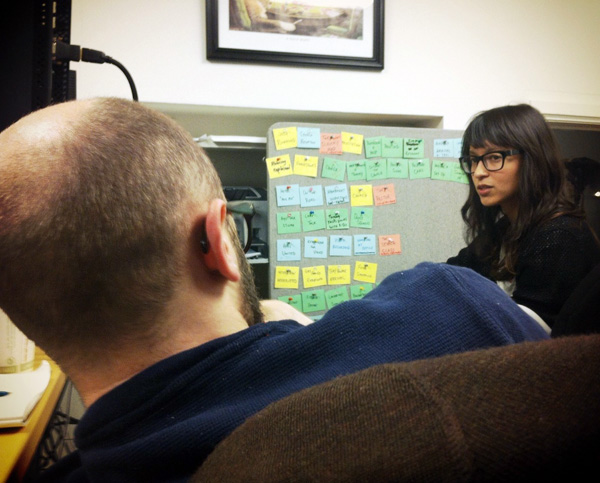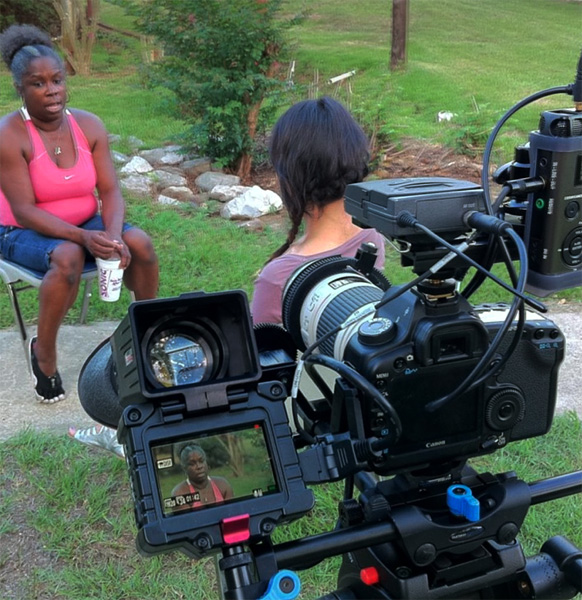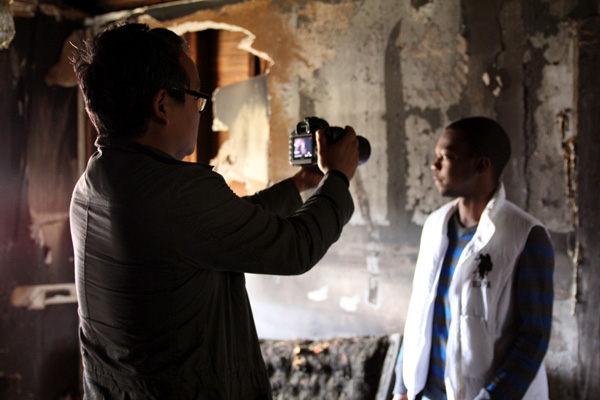Guest post by Duy Linh Tu:
deepsouth TRAILER (official) from Lisa Biagiotti on Vimeo.
About 18 months ago I was hired to shoot and produce deepsouth, a documentary about the rise of AIDS in the southern United States. I did not know much about the topic. To me, AIDS was a disease that, while terrible, was largely under control and had been so for years; it was something that was happening in Africa and Asia, in communities far away from my backyard. I was wrong. I learned that the number of new cases of HIV/AIDS in places such as Mississippi, Louisiana, and Alabama was rising at a rate higher than anywhere else in the country. African American men and women were the most affected. And the disease, which had often been associated with large urban areas, was now infiltrating and attacking rural communities.
Lisa Biagiotti, the film’s director, was determined to tell this story in a non-traditional way. With health or policy stories, journalists often fall into the trap of reporting on reports, focusing on stats rather than human experiences. While the numbers (how many people were infected, the rate of increase etc) were undoubtedly important to give context, Lisa wanted to focus on the people living with the disease. She wanted the documentary to be more cinematic and less broadcast in style; we wanted it to feel like a film. She also wanted to make the environment – the South – an important and obvious part of the story.

There were several challenges to shooting this film. First, HIV/AIDS is a topic often ignored in many areas of the South and homosexuality is still considered a sin by many. This made it difficult to find sources who could open up about having HIV/AIDS or being gay. When we did finally find characters to talk to us on camera, we needed to be discreet; some of them were still not out in their communities and they did not want to attract any attention to themselves. We could not use big rigs, huge lighting kits, or gear that took too long to set up. We needed to work quickly and quietly.
All of the gear that I used on this trip fitted into a Lowepro Fastpack 350 backpack and a carry-on suitcase that also held all my clothes and personal items. Lisa and I were the only crew on the shoots. I shot on a 5D mkII (using the Technicolor Cinestyle profile). My main lens was the Canon 24-105mm F4L IS. I also brought along a Canon 70-200mm F4L IS and a Canon 100mm F2.8L Macro, but these were used very sparingly. For audio in run-and-gun situations, I ran my Sennheiser ME-66 or a lav into a Marantz PMD-620 audio recorder then the line out into the camera (the line signal was attenuated). If I had time to set things up or required two audio inputs, I would run my mics through a Sound Devices Mix-Pre. I recorded all of the audio in the camera so that I would not require syncing (I found that that if I set the Mark II’s manual audio gain to about 25%, I got really high quality audio with low noise). I also monitored most of my shots with a Zacuto EVF.

I could not have been as fast or nimble with any other set up. Often, I only shot with the camera – no EVF, no audio setup. In certain situations, such as the footage of our character walking around an abandoned house, a big set up would have ruined the quiet mood of the scene. Because I had a separate audio recorder, I later went back and recorded rich, natural audio from the house and layered it in post-production.
Another added benefit of shooting with the DSLR alone was how intimate I could get with my subjects. A DSLR is recognizable to anyone, and that familiarity helped my characters relax quickly. Had I been shooting on a larger camera such a Sony F3, or even an EX3, I am not sure they would have “forgotten” about me as quickly. Also, my 100mm Macro lens allowed me to get tight shots without getting too close to my characters, and the lens’s IS helped smooth out my shooting.

Because we intentionally did not bring lights for these shoots – again, we were required to be discreet – we relied on natural light for most of our scenes. This was a challenge, but the Mark II performed remarkably well even at 6400 ISO. Some scenes were slightly noisy, but the clips did not break up in grading. A little de-noising with Magic Bullet also cleared up most of the shots. If I had not shot on the 5D Mark II, I am positive I would have lost many scenes.
We wrapped up shooting about nine months ago, and since then cameras such as the Nikon D800 and the 5D Mark III have come out. With each camera release, there has been a flood of pixel-peeping critiques about performance. Surprisingly, a lot of the reviews online have been negative – the cameras have sharpness problems, insufficient codecs, and on and on. But, I now own a new Canon 5D mkIII and I can honestly say it is a better camera for my needs than the Mark II. It would have been great for deepsouth.
But this brings me back to the original point of deepsouth: we wanted to get away from the numbers and focus more on the story and human experience behind those stats. I think this could be applied to videography these days as well – shooters should get away from pixel-peeping and get into figuring out what these great cameras can do in the field. Having a Mark III a year ago would have been great, but neither my shooting nor story would been better.
I believe we reached an amazing technological point with the Mark II, and things have only gotten better. Even with an $850 Canon T4i these days, you can shoot an amazing documentary and truly not want much more in terms of image quality. You can just focus on storytelling and capturing the experiences of your subjects. And, in the end, that is all that matters.
Duy Linh Tu is Assistant Professor and Director of Digital Media at the Graduate School of Journalism, Columbia University.
deepsouth will be premiering in Washington, DC on July 23rd, 2012






